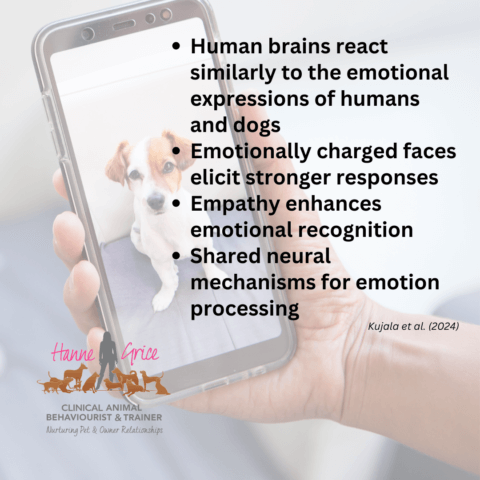
A recent study by Kujala et al. (2024) has taken a closer look at how empathy shapes the human brain’s ability to interpret emotional expressions in humans and dogs.
The researchers’ primary goal was to explore how humans process emotional expressions, focusing on both human and dog faces. Specifically, it explored whether the human brain responds to emotional expressions from dogs in ways similar to human expressions, providing insights into shared neural mechanisms. Additionally, the research examined whether certain emotions, such as happiness or aggression, elicit stronger brain responses than neutral expressions, regardless of species. Another central aim was to understand the role of empathy in recognising emotional expressions, particularly from dog faces, and how it influences interspecies communication. This research built on previous studies that suggested humans are adept at recognising dog emotions, but it took a novel approach by directly measuring brain activity to uncover the underlying neural mechanisms.
How the study was conducted
The study published in Social Cognitive and Affective Neuroscience used advanced brain imaging techniques, including i) magnetoencephalography (MEG), which measures tiny magnetic fields generated by brain activity, providing precise timing of neural responses, and ii) electroencephalography (EEG), which records electrical activity in the brain to complement MEG’s findings.
The study involved 15 adult participants, with no advanced training in handling dogs. Each participant viewed a series of carefully curated images showing human and dog faces expressing happiness, aggression, or neutrality, as well as images of objects and ‘phased scrambled’ photographs (this is a technique that randomises or jumbles the details, making the picture look like random noise, but keeps the overall light and dark areas the same). These images were standardised to remove distractions, such as variations in brightness or background, and included both coloured and greyscale versions to reduce the potential for biased results. The participants also completed a questionnaire to measure their empathy levels, which allowed researchers to explore the link between emotional understanding and brain responses.
What did they find?
The researchers investigations revealed the following…

- Human brains react similarly to the emotional expressions of humans and dogs. Within half a second of seeing an emotional face, participants’ brains activated regions associated with visual processing (occipital cortex), emotion recognition (temporal cortex), and attention (parietal cortex).
- Emotionally charged faces elicit stronger responses. Happy and aggressive faces, whether human or canine, activated the brain more intensely than neutral expressions. This demonstrates that emotionally significant faces demand greater attention. This makes sense considering this would have adaptive value; if someone or something is showing high arousal indicators, you want to pay attention as this increases your changes of survival (such as promoting cooperation, reproduction, or for flight/fight).
- Empathy enhances emotional recognition. Participants with higher empathy levels were better at distinguishing between happy and aggressive faces, especially when interpreting dog expressions. This suggests empathy enhances our ability to understand emotions, even across species.
- Shared neural mechanisms for emotion processing. The findings indicate that humans use similar brain pathways to process emotional expressions from both humans and dogs. This highlights the evolutionary basis of the human-dog bond, rooted in mutual emotional understanding. This supports previous research, such as Bunford et al. (2020), who demonstrated that domestication likely enhanced dogs’ ability to respond to human emotional cues, strengthening the human-dog dyad.
However, as with any study, there are some limitations. In this case, the sample size was small, so it may not represent how diverse groups of people process emotions in dogs and humans; it was conducted in laboratory conditions, which might not capture the complexity of real-life interactions with dogs, and most participants had little experience with dogs, and this could have impacted their ability to interpret canine emotions. Despite these limitations, future research opportunities include but are not limited to exploring how people interpret and respond to dogs’ emotions during real-life interactions, rather than relying on static photos, and whether increased knowledge about canine body language improves people’s ability to interpret dog emotions accurately and influences neural responses.
What does this mean for dog owners?
We know that dogs, like us, use visual signals to communicate and ‘leak’ information unconsciously via facial expressions and other body language cues. So this study helps highlight the importance of recognising signs of happiness (e.g. relaxed muscles, soft eyes, etc.) or unease/discomfort (e.g. tense face, direct stare, rapid blinking, etc.) and how empathy is involved in developing and maintaining the owner-dog relationship. Seeing the world through your dog’s perspective enables owners to interpret better and respond to their dog’s emotions in varied situations, such as when they are worried.
Hence, the emotional connection between humans and dogs isn’t just behavioural; it is also rooted in shared neural processes, and empathy in cross-species communication enables stronger, more fulfilling human-animal interactions and relationships.
References
- Bunford, N., Hernández-Pérez, R., Farkas, E. B. (2020). Comparative brain imaging reveals analogous patterns of face sensitivity in humans and dogs. Journal of Neuroscience, 40(50), 8396–8408. https://doi.org/10.1523/JNEUROSCI.2800-19.2020.
- Kujala, M. V., Somppi, S., Jokela, M. (2017). Human empathy, personality, and experience affect emotion ratings of dog and human facial expressions. PLoS One, 12(1). https://doi.org/10.1371/journal.pone.0170730.
- Kujala, M. V., Parkkonen, L., & Kujala, J. (2024). Empathy enhances decoding accuracy of human neurophysiological responses to emotional facial expressions of humans and dogs. Social Cognitive and Affective Neuroscience, 19(1). https://doi.org/10.1093/scan/nsae082
Learn more about our classes

Get Hanne's book, clothing and more
Hanne has a number of publications including her book Playing With Your Dog to help owners work out the games that are best suited for their pet to play throughout his life, from puppyhood to old age, available from Amazon. Check out Hanne's range of contemporary casuals The Collection – for pet lovers made from recyclable, organic materials that are sustainably sourced.

